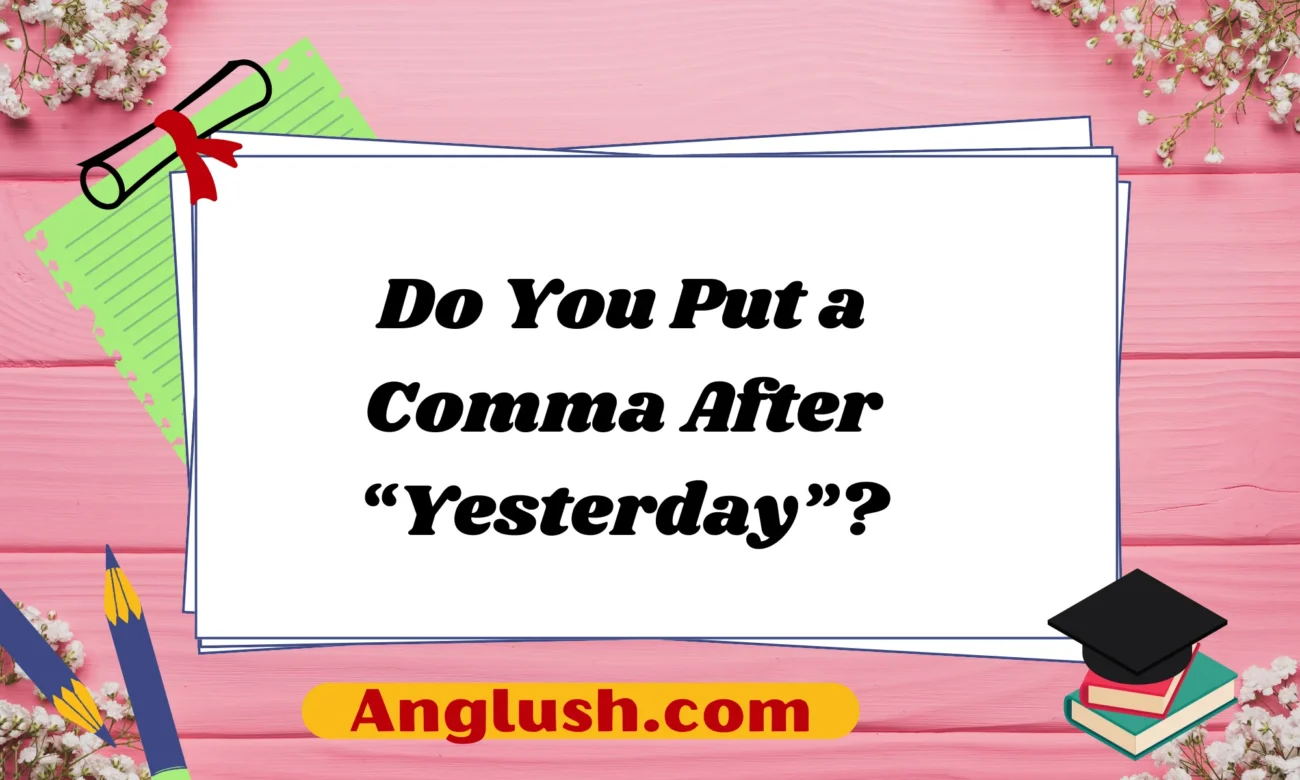When writing in English, punctuation plays a crucial role in ensuring clarity and readability. One common question that arises is whether to place a comma after the word “yesterday.” The answer depends on how the word is used within a sentence.
In this article, we will explore the grammatical rules and stylistic guidelines related to placing a comma after “yesterday.” We will examine different sentence structures, provide examples, and clarify when a comma is necessary. Additionally, we will provide ten user-friendly texting examples that illustrate proper comma usage in a digital communication setting.
Understanding Comma Placement After “Yesterday”
The need for a comma after “yesterday” depends on the word’s role in the sentence. The primary factors to consider include:
- Whether “yesterday” is functioning as an introductory element.
- If “yesterday” is part of a phrase requiring additional punctuation.
- The level of formality and clarity required in the sentence.
Let’s analyze different scenarios in which “yesterday” may or may not require a comma.
When to Use a Comma After “Yesterday”
1. When “Yesterday” Is an Introductory Element
If “yesterday” appears at the beginning of a sentence as an introductory word, a comma is generally needed for clarity.
✅ Correct:
- Yesterday, I went to the store.
- Yesterday, we had an important meeting.
In these cases, the comma helps separate the introductory word from the main clause, making the sentence clearer and easier to read.
2. When “Yesterday” Is Part of a Transitional Phrase
A comma is also required if “yesterday” is part of a longer introductory phrase.
✅ Correct:
- Yesterday morning, I received your email.
- Yesterday at noon, we met for lunch.
The comma ensures that the reader does not misinterpret the sentence structure.
3. When “Yesterday” Is Followed by a Parenthetical Expression
If “yesterday” is followed by a phrase that adds extra information, a comma should be used before and after the parenthetical phrase.
✅ Correct:
- Yesterday, as you may recall, we discussed this topic.
- Yesterday, in the middle of the meeting, he raised an important point.
These commas help set apart non-essential information, making the sentence more readable.
When NOT to Use a Comma After “Yesterday”
1. When “Yesterday” Is Used as a Subject or Object
If “yesterday” is the subject or object of a sentence, no comma is needed.
❌ Incorrect:
- Yesterday, was a great day. (Wrong)
✅ Correct: - Yesterday was a great day.
Here, “yesterday” functions as the subject, and adding a comma would disrupt the natural flow of the sentence.
2. When “Yesterday” Is Used in the Middle of a Sentence Without a Pause
If “yesterday” appears in the middle of a sentence without requiring a natural pause, a comma is unnecessary.
❌ Incorrect:
- I went to the store yesterday, and bought some groceries. (Wrong)
✅ Correct: - I went to the store yesterday and bought some groceries.
In this case, the sentence flows smoothly without a comma.
3. When “Yesterday” Is Used at the End of a Sentence
A comma should not be placed before “yesterday” when it appears at the end of a sentence.
❌ Incorrect:
- We had a great time, yesterday. (Wrong)
✅ Correct: - We had a great time yesterday.
Adding a comma before “yesterday” in this context would be grammatically incorrect.
10 Texting Examples with Correct Comma Usage
Texting and digital communication often involve short, concise messages. Below are ten user-friendly examples demonstrating proper comma placement with “yesterday.”
✅ Correct Usage in Texting:
- Yesterday, I forgot to reply to your message.
- Yesterday at noon, we talked about our plans.
- Yesterday, as I mentioned earlier, I had a doctor’s appointment.
- Yesterday morning, I sent you the details.
- Yesterday, we had a great time at the park!
- I checked the documents yesterday and everything looks good.
- We finished the project yesterday without any issues.
- He arrived late yesterday because of traffic.
- I completely forgot about the deadline yesterday.
- Can you remind me what we discussed yesterday?
These examples illustrate how to use commas correctly in everyday digital communication.
Key Takeaways: When to Use a Comma After “Yesterday”
| Situation | Comma Needed? |
| At the beginning of a sentence | ✅ Yes |
| Part of a longer introductory phrase | ✅ Yes |
| Followed by a parenthetical phrase | ✅ Yes |
| Used as a subject or object | ❌ No |
| In the middle of a sentence without a pause | ❌ No |
| At the end of a sentence | ❌ No |
Understanding when to use a comma after “yesterday” enhances clarity in writing and ensures proper punctuation.
Conclusion
The decision to place a comma after “yesterday” depends on its role in the sentence. When “yesterday” serves as an introductory element, a comma is necessary to separate it from the main clause. However, if it functions as the subject, object, or part of a sentence without a natural pause, a comma should be omitted.
By applying these guidelines, you can improve your writing, ensuring that your sentences are both grammatically correct and easy to read. Whether you are writing a formal email, a casual text, or a professional report, knowing when to use a comma after “yesterday” will help you communicate more effectively.

